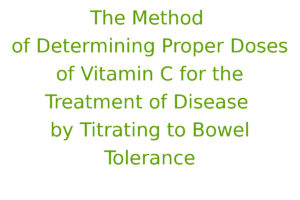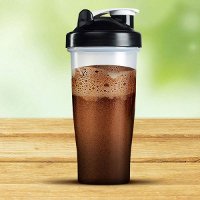Allergy, Environmental, and Orthomolecular Medicine
My experience (Cathcart 1975, 1976, 1978, 1979) in utilizing vitamin C in large doses has extended over a nine-year period and has involved over 9,000 patients. Much of the original work with large amounts of vitamin C was done by Fred R. Klenner M.D. (1948, 1949,1971,1974) of Riedsville, North Carolina.
Klenner found that viral diseases could be detoxified and subsequently cured by intravenous sodium ascorbate in amounts up to 200 grams per 24 hours. Irwin Stone (1965,1966,1972) pointed out the potential of vitamin C in the treatment of many diseases, the inability of humans to synthesize ascorbate and the resultant condition hypoascorbemia. Linus Pauling (1970, 1976) reviewed the literature on vitamin C and has led the crusade to make known its medical uses to the public and the medical profession. Ewan Cameron in association with Pauling (1976, 1978) has shown the usefulness of ascorbic acid in the treatment of cancer.
The purpose of this paper is to describe a method that maximizes the effectiveness of ascorbic acid taken orally for various diseases and stress processes. Much of the controversy about ascorbic acid has been due to studies utilizing totally inadequate doses of vitamin C. It seems incredible to the growing number of physicians familiar with the proper doses of ascorbic acid that recent papers would describe studies utilizing only up to four grams per 24 hours. Also the hypothesis that not only do humans suffer from chronic hypoascorbemia but that stress and disease can induce localized and systemic anascorbemia (a type of scurvy) will be presented.
Bowel Tolerance Method
In 1970, I discovered the sicker a patient was, the more ascorbic acid he would tolerate by mouth before diarrhea was produced. At least 80 percent of adult patients will tolerate 10 to 15 grams of ascorbic acid fine crystals in one half-cup water in four divided doses per 24 hours without having diarrhea. The astonishing finding was that almost all patients would absorb far greater amounts without having diarrhea when ill. This increased tolerance is somewhat proportional to the toxicity of the disease being treated. Tolerance is increased some by stress (e.g., anxiety, exercise, heat, cold, etc.).
Admittedly increasing the frequency of doses increases tolerance perhaps to half again as much; but the tolerance exceeding sometimes 200 grams per 24 hours was totally unexpected. Representative doses taken by patients titrating their ascorbic acid intake between the relief of most symptoms and the production of diarrhea were as follows:
| CONDITION | GRAMS ASCORBIC ACID PER 24 HOURS | NUMBER OF DOSES PER 24 HOURS |
|---|---|---|
| normal. well | 4 – 15 | 4 |
| mild cold | 30 – 60 | 6 – 10 |
| severe cold | 60 – 100 | 8 – 15 |
| influenza | 100 – 150 | 8 – 15 |
| ECHO, coxsackie virus | 100 – 150 | 8 – 15 |
| mononucleosis | 150 – 200+ | 12 – 18 |
| viral pneumonia | 100 – 200+ | 12 – 18 |
| hay fever, asthma | 15 – 25 | 4 – 8 |
| burn, injury, surgery | 25 – 150 | 6 – 15 |
| anxiety, exercise and other mild stresses | 15 – 25 | 6 – 15 |
| cancer | 15 – 100 | 4 – 15 |
| ankylosing spondylitis | 15 – 100 | 4 – 15 |
| rheumatoid arthritis | 15 – 100 | 4 – 15 |
| bacterial infections | 30 – 200+ | 10 – 18 |
It was found that maximum relief of symptoms, the most shortening of the course of the disease, and the greatest reduction in complications could be obtained by the oral doses just below the point causing diarrhea. The patient usually easily senses this titration to bowel tolerance. In many conditions symptoms are markedly suppressed but will return rapidly if the dose levels are not maintained long enough. In the case of very toxic diseases, doses may have to be taken every half hour. Even short delays in taking these doses may prolong the disease. The necessary duration of treatment is usually also easily sensed by patients.
Anascorbemia
The term “anascorbemia” is coined to mean complete absence of ascorbate from the blood. It accompanies the “acutely and chronically induced scurvy” discussed.
The object of this titration to bowel tolerance is to eliminate the “toxicity” of the disease and to maintain a high level of ascorbate in all tissues of the body especially the tissues directly involved by the disease process. Bearing in mind that almost continual sipping of ascorbic acid would be optimum especially with the more toxic diseases, for practical purposes compromise to the number of doses listed often suffices. Apparently there is an almost unbelievable and unappreciated potential draw by diseased tissues on ascorbic acid. Only by fully satisfying this “need” of stressed tissues can the condition of anascorbemia and localized scurvy be absolutely prevented. Fully satisfying this need probably accounts for the striking amelioration of symptoms just before bowel tolerance is reached. This need for ascorbate is probably the reason many toxic diseases or stressful situations produce complications or even secondary diseases later on. The induced anascorbemia may predispose to pneumonia, heart attacks, phlebitis, Guillian‑Barre syndrome and perhaps rheumatoid arthritis and cancer.
It is my custom to speak of 20 to 100 gram colds, etc. A 100-gram cold would mean that the patient is capable of ingesting 100 grams of ascorbic acid per 24 hours at the peak of the disease. In the case of systemic viral infections, it is often more important to properly estimate what gram disease it is and persuade the patient to take adequate doses than to know what virus is being treated. A patient who learns to start titrating at the earliest symptoms of a disease will have the best results. Nevertheless, adequate doses will usually reduce symptoms even late in the disease.
By this method large amounts of ascorbate are spilled in the urine; but this is necessary to push adequate amounts of ascorbate into the tissues of the very seat of the disease and maintain full vitamin C functions. One who argues that ascorbate can have no effect above renal threshold misses the point entirely and would, I suppose, maintain that one could not become more intoxicated on ethyl alcohol above renal threshold. Also, large amounts of ascorbate in the urine will prevent many kidney and bladder infections.
In the case of the more “toxic” conditions, half‑hourly doses may be necessary. Absorption and presumably destruction of ascorbate occur so rapidly as to require this frequency of doses for adequate amounts of ascorbic acid to keep the diseased tissues saturated without requiring too large doses that produce diarrhea. Even short delays in taking these doses may prolong the disease and reduce the effectiveness of ascorbic acid in blocking symptoms.
Infants and children tolerate ascorbic acid remarkably. I encourage the use of water rather than juice because the unsweetened taste aids in helping the patient select the proper dose. Juice is allowed only if the child refuses doses otherwise. Children 10 years old take adult doses; most teenagers take half again as much as adults. Older adults often tolerate ascorbic acid less well and more frequently require intravenous ascorbate. Young children refusing to take oral ascorbic acid often will subsequently take oral doses after intramuscular injections of ascorbate. Although this method of persuasion seems cruel it is better than the complications of serious diseases and probably hurts no more than a penicillin shot.
IM and IV Injections
Per gram intravenous and intramuscular sodium ascorbate is more effective than oral ascorbic acid, (Klenner, 1971; Kalokerinos, 1974). Solutions of sodium ascorbate 250 mg per cc with no preservative except for EDTA must be used. The volume of a single IM injection can be as much as one could give as a saline shot. Usually 2 cc is used; sometimes a little more, sometimes in two sites. The object of the intramuscular injection is to avert a crisis, break the fever, etc. Usually very rapid conversion to oral doses is possible.
In adults, intravenous injections can be made with the same 250 mg per cc solutions in pushes of 10 cc or very slowly up to 50 cc. Care is necessary here to make sure that the vein does not hurt as the injection is made and that the patient does not dehydrate or have tetany.
IV bottles can be prepared by using lactated Ringers’, one half normal saline, or normal saline and diluting solutions to 60 grams sodium ascorbate per liter. At this concentration sterile water can be used but care must be taken to make absolutely sure straight sterile water is never given. These solutions can be run in two to eight hours for a liter. It is my experience that sodium ascorbate intravenously in an edematous patient will usually act as a diuretic. However, one should think about the sodium and examine the patient frequently. The most frequent difficulty is dehydration or tetany from running solutions too rapidly. Oral water will prevent dehydration. A 10 cc vial of calcium gluconate one gram should be added to one bottle per day if solutions are run more than one day. Remember that most patients will convert to oral doses of ascorbic acid rapidly. In some cases such as severe viral or bacterial pneumonias, one may want to give IV solutions of ascorbate at the same time that oral doses are being given.
Mononucleosis
Mononucleosis responds dramatically to ascorbic acid although the doses required can be very high. Early in this study a 23 year old, 98 pound female librarian with severe mononucleosis claimed to have taken two heaping tablespoons every two hours consuming a full pound of ascorbic acid in two days. She felt mostly well in three to four days although she had to continue about 20 to 30 grams a day for about two months. Most cases do not require maintenance doses for more than two to three weeks. The patient can sense the duration of need. Professional ski patrol patients can be back on the slopes in a week. I care mostly that they carry their boda bags full of ascorbic acid in solution on the hills with them so as to keep the disease detoxified almost completely while the infection persists. Lymph nodes and the spleen return to normal rapidly.
Viral Hepatitis
Viral hepatitis of all types, in my experience, is one of the easiest diseases for ascorbic acid to cure. A difficulty is that hepatitis often causes diarrhea; so titrating to bowel tolerance is more difficult. However, with experience one judges what gram disease it is and gives this amount regardless of diarrhea. This amount could be from 40 to 100 grams. It becomes obvious whether it is the disease or the ascorbic acid causing the diarrhea very soon. There is usually a paradoxical stopping of the diarrhea within a day or two. If too much difficulty is experienced in judging the dosages, intravenous ascorbate is extremely effective. Stools and urine return to normal color within two to three days in acute cases. Chronic cases take longer but in my experience respond rapidly. In acute cases the patient will usually feel fairly well in two to four days but it usually takes the jaundice about six days to clear. There would appear to be a staining of the skin that persists even though physical findings and laboratory results return rapidly to normal. SGOT and SGPT values so high as not to be measurable rapidly fall and reflect objectively the subjective feelings of the patient.
Gastroenteritis
Gastroenteritis of viral origin responds very rapidly but one must titrate boldly and anticipate paradoxical stopping of the diarrhea. If titration starts in the first hour of the disease, experienced ascorbic acid takers may never develop the diarrhea and only suspect what they have avoided because of the disease being epidemic. These diseases may require 60 to 150 grams of ascorbic acid to almost totally block symptoms. If a patient over‑titrates and develops diarrhea from the ascorbic acid, the change in character of the diarrhea to a relatively painless, less foul, more like a watery enema diarrhea, and generalized relief of malaise signals that the doses should be lowered.
Other acute self-limiting viral diseases respond similarly when the patient titrates properly. Antihistamines and decongestants should be used when appropriate.
Belfield and Stone (1975) have observed similar results in veterinary medicine with usually fatal viral diseases when intravenous ascorbate is utilized.
Bacterial Infections
Ascorbic acid should be used in conjunction with the appropriate antibiotic. The effect of ascorbic acid is synergistic with antibiotics and would appear to broaden the spectrum of antibiotics considerably. The incidence of allergic reaction to penicillin in patients “saturated” with ascorbate is almost zero. One must understand that ascorbate does not always effectively protect against allergic reactions until the patient has titrated up to bowel tolerance. If a patient has an allergic reaction to penicillin before bowel tolerance is reached subsequent “saturation” with ascorbate in conjunction with usual medications will more rapidly than expected resolve the reaction. It is especially interesting that mononucleosis would appear to cause more rapid destruction of ascorbate than other commonly encountered viral diseases. The high incidence of allergic reaction to penicillin in patients mistakenly given penicillin when they have mononucleosis is usually prevented by saturation with ascorbic acid. It is probable that this high incidence of allergic reaction to penicillin in mononucleosis patients is due to the tremendous draw on ascorbate by the disease.
It has been my experience the indications for ampicillin are markedly reduced by ascorbic acid because of the synergism with Penicillin K and vitamin C.
Candida Albicans
Candida infections occur less frequently in patients being treated with antibiotics if bowel tolerance doses of ascorbic acid are simultaneously used. Ascorbic acid seems to have little effect on established candida infections. It should be used, nevertheless, to help the patient with the stress of the disease.
Fungal Infections
Although ascorbic acid should be given in some form in some way to all sick patients to help them meet the stress of the disease, it is my experience that ascorbate has little effect on the primary fungal infection. It will probably be found certain complications can be reduced in incidence. It may be found that appropriate ant fungal agents will penetrate tissues saturated in ascorbate better.
Trauma, Surgery
Swelling and pain from trauma and surgery is markedly reduced by bowel tolerance doses of ascorbic acid. Doses should be given a minimum of six times a day. More major surgeries should require intravenous sodium ascorbate postoperatively. The effect of ascorbate on anesthetics should be studied. Barbiturates and many narcotics are blocked. Refer to the work of Libby and Stone (1977). The need for these substances postoperatively is greatly reduced.
Cancer
I have avoided the treatment of cancer patients for legal reasons; however I have given nutritional consults to a number of cancer patients and have observed an increased bowel tolerance to ascorbic acid. Were I treating cancer patients, I would not limit their ascorbic acid ingestion to a set amount but would titrate them to bowel tolerance. Ewan Cameron’s advice against giving cancer patients with widespread metastasis large amounts of ascorbate too rapidly at first should be heeded. He found that sometimes extensive necrosis or hemorrhage of the cancer could kill the patient if the vitamin was started too rapidly in patients with widespread metastasis. Hopefully, ascorbic acid will become the first treatment given cancer patients and not the last. The nutritional treatment of cancer should not be limited to ascorbic acid.
Stress and Disease in General
After considerable experience with patients in stressful situations, (Cathcart, 1979) and with diseases producing stress, it is my opinion that saturation with ascorbate continuously has markedly reduced the incidence of secondary complications. It is difficult to prove, but it is my definite impression the incidence of disease months following stress is reduced.
Allergies
Hay fever and asthma are most frequently benefited. Sometimes, pantothenic acid and/or vitamin B6 is helpful in acting synergistically with ascorbic acid. Frequently, hay fever and asthma are benefited at dose levels lower and more comfortable than bowel tolerance doses. However, treatment should be begun with bowel tolerance doses at least six times a day so that the response of some more. difficult cases will not be missed.
Back Pain from Disc Disease
Greenwood (1964) observed that one gram a day would reduce the incidence of necessary surgery on discs. At bowel tolerance levels, ascorbic acid more markedly reduces pain about 50 percent and lessens the difficulties with narcotics and muscle relaxants. It is not the total answer for back pain patients however.
Ankylosing Spondylitis and Rheumatoid Arthritis
Ankylosing spondylitis and rheumatoid arthritis increases bowel tolerance. Clinical response varies. Sometimes, these diseases are put into remission; sometimes not. I would advise the patient’s increased needs for ascorbate be met regardless.
Scarlet Fever
Three cases with typical sandpaper‑like rash, peeling skin, and diagnostic laboratory findings of scarlet fever have responded within an hour or overnight. It is thought this immediate response is due to the neutralization of the small amount of residual streptococcus toxin causing the disease.
Herpes: Cold Sores, Genital lesions, and Shingles
Acute herpes infections are usually ameliorated with bowel tolerance doses of ascorbic acid. However, recurrences are common especially if the disease has already become chronic. Zinc in combination with ascorbic acid is more effective for herpes infections.
Crib Deaths (Sudden Infant Death Syndrome)
I would agree with Kalokerinos (1974) and Klenner (1971) that crib deaths are caused by sudden ascorbate depletions. The induced anascorbemia in some vital regulatory center kills the child. This induced deficiency is more likely to occur when the diet is poor in vitamin C. All of the epidemiological factors predisposing to crib deaths are associated with low vitamin C intake or high vitamin C destruction. I have never heard of a crib death in an infant saturated with ascorbate.
Maintenance Doses
I advise patients to take bowel tolerance doses of ascorbic acid for about a week and observe if anything beneficial happens. Some patients clear sinuses, or get a lift from it, etc. In these cases, doses are reduced to a comfortable effective level. If a patient feels nothing then the amount is lowered to about four grams a day divided in about three to four doses for a good day. During a stressful day, doses are raised to a total of perhaps 10 grams or more. When ascorbic acid crystals are used dissolved in a small amount of plain water, the patient usually develops a taste for the substance that tells him how much to take. At the slightest hint of a threatening viral disease, doses are increased in frequency and to bowel tolerance.
In many patients viral infections still occur despite high ascorbic acid intake, although the symptoms of the disease will be mostly ameliorated. Vitamin A 25,000 iu to 50,000 iu per day should be taken if high doses of ascorbic acid are maintained for more than several months. Supplements of all essential minerals should also be taken along with long‑run maintenance doses of ascorbate. Avoidance of sugar and processed foods will prove valuable if a patient’s goal is almost complete prevention of viral diseases.
Complications
It is my experience that ascorbic acid never causes kidney stones, but in fact, probably prevents them. Acute and chronic urinary tract infections are usually eliminated. One patient in a thousand will experience some dysuria. A small number will have a light rash usually clearing with subsequent doses. Patients with hidden peptic ulcers may have pain but some are benefited. The few patients complaining of canker sores with small doses of vitamin C do not usually have problems with large bowel tolerance doses. Patients with canker sores should be given large doses of vitamin E.
Some patients complaining of acid conditions do not tolerate ascorbic acid. These cases are very few. Older patients will have more nuisance problems with ascorbic acid and have more difficulty reaching bowel tolerance.
Patients started on maintenance doses of ascorbic acid when well will have a moderately high incidence of nuisance complaints. Patients treated with bowel tolerance doses for acute diseases have very few complaints because of the increased tolerance and the marked relief of symptoms. It is my experience that high maintenance doses of ascorbic acid reduce the incidence of gouty arthritis. I have not had difficulties giving large amounts of ascorbic acid to patients with gout.
Almost all of my patients have been Caucasian, so I have no comment on the recent report that ascorbic acid causes certain blood problems in certain non‑white groups (Campbell, Steinberg, Bower, 1975).
There has been no evidence as Herbert and Jacob (1974) suspected that ascorbic acid destroys vitamin B12.
The major problem, if one wishes, to call it a problem, is a certain dependency on ascorbic acid that a patient acquires over a long period of time when he takes large maintenance doses. Apparently, certain metabolic reactions are encouraged by large amounts of ascorbate and if the substance is suddenly withdrawn, certain problems result such as a cold, return of allergy, fatigue, etc. Mostly, these problems are a return of problems the patient had before taking the ascorbic acid. Patients have, by this time, become so adjusted to feeling better that they refuse to go without ascorbic acid. Patients do not seem to acquire this dependency in the short time they take doses to bowel tolerance to treat an acute disease. Maintenance doses of four grams per day do not seem to create a noticeable dependency. The majority of patients who take 10 to 15 grams of ascorbic acid per day probably have a certain metabolic need for ascorbate that exceeds the universal human species need.
The major problem feared by patients benefiting from these large maintenance doses of ascorbic acid is that they may be forced into a position when their body is deprived of ascorbate during a period of great stress such as emergency hospitalization. Physicians should recognize the consequences of suddenly withdrawing ascorbate under these circumstances and be prepared to meet these increased metabolic needs for ascorbate in even an unconscious patient. These consequences that may include shock, heart attack, phlebitis, pneumonia, allergic reactions, etc., can be averted only by intravenous ascorbate. All hospitals should have supplies of large amounts of ascorbate for intravenous use to meet this need. The millions of people taking ascorbic acid makes this an urgent priority. Patients should carry warning of these needs in a card prominently displayed in their wallets or should have a Medic Alert type bracelet engraved with this warning. Physicians should, in addition, carefully ask patients’ families about the patients’ ascorbic acid maintenance doses. Regardless of a physician’s philosophical feelings about the usefulness of vitamin C, the physician should not withhold this essential nutrient from patients who have previously adjusted their body’s metabolism to their increased needs. It would be like withholding vitamin 812 from a patient with pernicious anemia just because he was hospitalized. In the case of ascorbic acid, the effect would be much more rapid however.
Conclusion
The method of titrating a patient’s dosage of ascorbic acid between the relief of most symptoms and bowel tolerance has been described. This titration method is absolutely necessary to obtain excellent results. Studies of lesser amounts are almost useless. This method cannot by its nature be studied by double blind methods because no placebo will mimic this bowel tolerance phenomenon. The method produces such spectacular effects in all patients capable of tolerating these doses, especially in the cases of acute self‑limiting viral diseases as to be undeniable. A placebo could not possibly work so reliably, work in infants and children, and have such a profound effect on critically ill patients. More stable patients will tolerate bowel tolerance doses of ascorbic acid and almost “uniformly have excellent results. The more suggestible unstable patient is more likely to have difficulty with the taste.
References & External links
- BELFIELD, W.D. and STONE, I.: Megascorbic Prophylaxis and Megascorbic Therapy: A New Orthomolecular Modality in Veterinary Medicine. Journal of the International Academy of Preventive Medicine 2:10‑26, 1975.
- CAMERON, E. and PAULING, L.: Supplemental Ascorbate in the Supportive Treatment of Cancer: Prolongation of Survival Times in Terminal Human Cancer. Proc. Natl. Acad. Sci. USA 73:3685‑3689, 1976.
- CAMERON, E. and PAULING, L.: The Orthomolecular Treatment of Cancer: Reevaluation of Prolongation of Survival Times in Terminal Human Cancer. Proc. Natl. Acad. Sci. USA 75:4538‑4542, 1978.
- CAMPBELL, G.D. Jr., STEINBERG, M.H. and BOWER, J.O.: Ascorbic Acid Induced Hemolysis in G‑6‑PD Deficiency. Ann. Int. Med. 82:810, 1975.
- CATHCART, R.F.: Clinical Trial of Vitamin C. Medical Tribune. June 25, 1975.
- CATHCART, R.F.: Clinical Use of Large Doses of Ascorbic Acid. Presented at the Annual Meeting of the California Orthomolecular Medical Society, San Francisco, February 19, 1976.
- CATHCART, R.F.: Vitamin C as a Detoxifying Agent. Presented at the Annual Meeting of the Orthomolecular Medical Society, San Francisco, January 21, 1978.
- CATHCART, R.F.: Vitamin C‑The Missing Stress Hormone. Presented at the Annual Meeting of the Orthomolecular Medical Society, San Francisco, March 3, 1979.
- GREENWOOD, J.: Optimum Vitamin C Intake as a Factor in the Preservation of Disc Integrity. Medical Annals of the District of Columbia 33:274‑276, 1964.
- HERBERT, V. and JACOB, E.: Destruction of Vitamin B12 by AscorbiC Acid. JAMA 230:241-242, 1974.
- KALOKERINOS, A.: Every Second Child, Thomas Nelson, Australia, 1974.
- KLENNER, F.R.: Virus Pneumonia and its Treatment with Vitamin C. J South. Med. and Surg. 110:60-63, 1948.
- KLENNER, F.R.: The Treatment of Poliomyelitis and Other Viral Diseases with Vitamin C. J. South. Med. and Surg. 111:210-214, 1949.
- KLENNER, F.R.: Observations on the Dose and Administration of Ascorbic Acid when Employed Beyond the Range of a Vitamin in Human Pathology. J. App Nutr. 23:61-88, 1971.
- KLENNER, F.R.: Significance of High Daily Intake of Ascorbic Acid In Preventive Medicine. J. Int. Acad. Prev. Med. 1:45-49, 1974.
- LIBBY, A.F. and STONE, I.: The Hypoascorbemia Kwashiorkor Approach to Drug Addiction Therapy A Pilot Study. J. Ortho. Psychiat. 6:300- 308, 1977.
- PAULING, L.: Vitamin C and the Common Cold. W.H. Freeman and Company, San FrancIsco. 1970, Linus Pauling, Vitamin C and the common cold, Can Med Assoc J. 1971 Sep 4; 105(5): 448, 450. PMCID: PMC1931292.
- PAULING, L.: Vitamin C, the Common Cold, and the Flu. W.H. Freeman and Company, San Francisco, 1976.
- STONE, I.: Studies of a Mammalian Enzyme System for Producing Evolutionary Evidence on Man. Am. J. Phys Anthro 23:83-86, 1965.
- STONE, I.: Hypoascorbemia: The Genetic Disease Causing the Human Requirement for Exogenous Ascorbic Acid. Perspectives in Biology and Medicine 10:133-134, 1968.
- STONE, I.: The Healing Factor Vitamin C Against Disease. Grosset and Dunlap, New York, 1972.
Journal of Orthomolecular Psychiatry 10:125-132, 1981











Comments
“The Method of Determining Proper Doses of Vitamin C for the Treatment of Disease by Titrating to Bowel Tolerance”